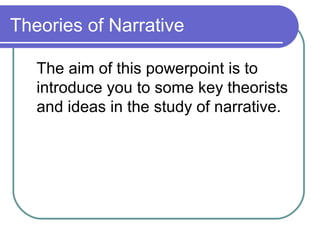
Narrative theory
- 1. Theories of Narrative The aim of this powerpoint is to introduce you to some key theorists and ideas in the study of narrative.
- 2. Definitions of Narrative… Narrative: The story - what happens or what is depicted, actions, events and characters. Narration: How the story is told, how the information is presented to viewers, e.g. visual style and point of view the story is told from.
- 3. Narrative structure Linear/Chronological Non Linear – Pulp Fiction, Memento Cyclical – Groundhog day/Run Lola Run Cause and effect – often motivated by the needs and wishes of the characters. Single/Multiple viewpoints – who is telling us the story?
- 4. Omniscient/Restricted Narration Restricted narration –we see an event through the viewpoint of only one person. This can add surprise as we only discover events alongside them Omniscient narration – when we see events from multiple viewpoints. This can add suspense as we are privy to information other characters are not.
- 5. Tvzetan Todorov Franco-Bulgarian philosopher who coined the term narratology = to look at units of meaning in a text Claimed all stories had a basic structure based on equilibrium
- 6. Traditional/Hollywood Narrative Equilibrium (sense of order/calm) A disruption of this equilibrium by an event A realisation that a disruption has happened An attempt to repair the damage of the disruption A restoration of the equilibrium which may be a new or changed one
- 7. Roland Barthes French critic Identifies 5 ‘codes’ of narrative Proairetic code Hermeneutic code Cultural code Semic code Symbolic code
- 8. The Hermeneutic Code Thiscode poses questions or enigmas which provide narrative suspense. As audiences the unravelling of these codes and thinking about the questions posed by events provide viewing pleasure Use this when thinking about the narrative of a film trailer
- 9. Vladimir Propp Russian The Morphology of the Folk Tale (1928) Stated that all fairytales have common narrative structures and character functions
- 10. 31 Functions of Fairytales Propp identified 31 key functions in his analysis of Russian folktales Not all 31 had to be present, however, they did always follow the same sequential order These functions were performed by one of 8 main character types that advanced the action
- 11. Claude Levi-Strauss Argued that meaning in narratives is based on binary oppositions. He was less interested in the arrangement (syntagmatic) of the narrative than in the deeper meaning (paradigmatic)of themes
- 12. Binary Oppositions Binary oppositions are opposite values that reveal the structure of media texts. It is important to look at the denotations (literal meaning) and connotations (cultural significance) of the sign.
- 13. Binary Oppositions Hero Coward Natural Artificial Good Evil Male Female Rational Emotional Strong Weak Day Night Appearance Reality Man Alien/Machine /technology
- 14. Summary TODOROV’S structure theory of equilibrium, disequilibrium, new equilibrium PROPP’S THEORY –8 character types, 31 Functions in Folktales BARTHES’ ENIGMA CODE –the narrative functions to establish and then solve mysteries. (Trailers) LEVI-STRAUSS’ BINARY OPPOSITION – Themes Narrative tension is based on opposition or conflict. but more often functions at an ideological level – e.g., in Sci-fi what do the aliens and people each represent?
- 15. References Barry, P (1995) Beginning Theory. Manchester: Manchester University Press. Fell, J.L. (1977) ‘Vladimir Propp in Hollywood’ in Film Quarterly. Vol. 30, No.3pp19-28 Propp, Vladimir. (1928) Morphology of the Folk Tale. Excerpts available from: http://homepage.mac.com/allanmcnyc/textpdfs/propp.pdf Todorov, Tzvetan & Weinstein, Arnold. (1969) ‘Structural Analysis of Narrative’ in NOVEL: A Forum on Fiction. Vol. 3, No 1, pp70- 76 Todorov, Tzvetan. (1971) ‘The 2 Principles of Narrative’ in Diacritics. Vol. 1, no 1, pp37-44. Whalen, Tom. (2000) ‘Run Lola Run’ in Film Quarterly. Vol. 53, No.3, pp33-40.